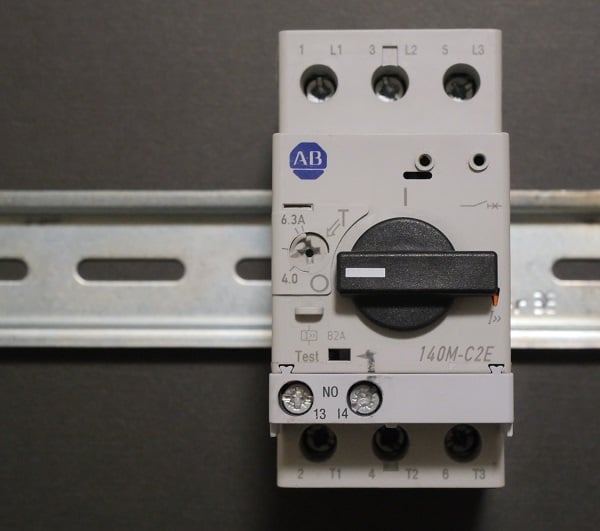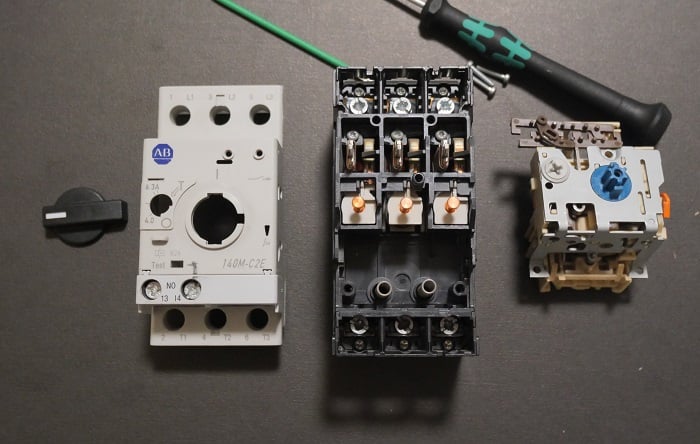We depend on circuit breakers all the time, even when you have a day off or work from home. These overcurrent protection devices keep machines running safely, reducing the risk of fires and arcing.
Circuit breakers are overcurrent protection devices found in commercial, residential, industrial, and agricultural applications. In the manufacturing environment, these are most often found mounted on DIN rails in cabinets near controllers, actuators, and other electrical equipment. Their purpose is to interrupt the flow of current through a branch or loop of a circuit, preventing equipment damage or overheating of components.
In spite of popular belief, circuit breakers are not generally designed to prevent electrical shock, since there are other devices (like ground fault circuit interrupts, GFCIs) that are better suited for this purpose. Circuit breakers are also not fuses. While fuses interrupt the flow of current, they do so by melting a filament of wire, meaning a fuse is only good for one fault. Circuit breakers can be reset.

Figure 1. A DIN rail-mounted 3-pole circuit breaker.
How Does a Circuit Breaker Work?
There are two common mechanisms for interrupting the flow of current inside a circuit breaker. The first, electromagnetic, is used for stopping high current flow, usually due to short circuit events (these are mainly for resistive loads). The second, thermal, is used to stop moderately high currents that persist for extended periods of time (for inductive loads).
Electromagnetic Circuit Breaker
When current flows through a wire, it generates a magnetic field. The strength of the magnetic field is proportional to the amount of current flowing through the wire. Electromagnetic circuit breakers take advantage of this effect.
In an electromagnetic circuit breaker, there is a magnetic lever that is sized according to the maximum current that can safely flow through the circuit. If the current is higher, the magnetic field will be strong enough to attract the lever. Once the lever begins to move, it will pull a strip of conductor out of the circuit, breaking the flow of current.
To assist in the breaking of the circuit, the electromagnetic circuit breaker is equipped with a spring. Once the lever moves a small distance, the spring tension is released, allowing the breaker to snap open. Without this spring action, large currents may start to weld the circuit breaker closed and not allow it to break open.
Electromagnetic circuit breakers can catch rapid changes in current flow. This makes them a great way to open circuits during brief surges that arise from short circuits or spikes in a power supply. Sometimes this can be a nuisance triggering from a short inductive spike, but it’s much safer to have a safety switch that opens in any dangerous situation.
Thermal Circuit Breaker
Besides generating an electric field, current flowing through a conductor generates heat. The amount of heat generated is proportional to the square of the current, in other words:
Q = I2R
Where Q is the heat energy released, I is the current, and R is the resistance of the conductor.
This is both the problem and part of the solution. The heat released with high currents is what leads to thermal damage and fire potential. It can also be used to open a circuit breaker.
Thermal circuit breakers, sometimes called thermal switches, contain a bimetallic thermal actuator strip that responds to the rising temperature. The bimetallic strip contains two pieces of metal welded together. Because the two different types of metal have different coefficients of thermal expansion, a change in temperature means the bimetallic strip will bend in one direction or another. This torque can be used to move a linkage that allows a spring to release, which moves the conductor out of the circuit.
Thermal circuit breakers are typically used to prevent overheating during relatively long-term usage (less than a second to a few seconds, depending on the ‘curve’ or ‘trip class’). They can be used to detect high current draws for extended periods of time.
Combination Thermal-Magnetic Circuit Breaker
For the best of both worlds in an inductive industrial setting, combination circuit breakers have both an electromagnetic element and a thermal element. Because the circuit breaker contains both elements, the typical arrangement is for the electromagnetic element to handle a higher current than the thermal element. This way, a brief current surge can be disconnected by the electromagnetic element, and the thermal element will trigger if a slightly higher current runs for an extended period of time.
As an example, consider the current draw to a pump’s motor. At startup, there is a large, brief inrush current that overcomes static friction. The electromagnetic circuit breaker must be able to tolerate the high inrush current, but if it’s a bit too high, the magnetic breaker will trip.
Once the motor is running, the current to the motor will decrease. However, if an excessively high running current persists for too long, the thermal circuit breaker will open due to the increased heat.

Figure 2. A view of both the magnetic (copper coil) and thermal (bimetallic strip just above the coil) devices inside the circuit breaker housing.
Without the electromagnetic circuit breaker, an electrical short, say from a winding to the grounded case, could go unchecked until the motor heats up and the thermal switch activates. By then, a fire may have already started. Without the thermal circuit breaker, the motor could theoretically run at the high inrush current for a long time, heating up. Because many components are designed to tolerate the inrush current only briefly, the absence of the thermal circuit breaker could also lead to fire or thermal degradation of components.
Combining both circuit breaker types provides extra protection for multiple types of electrical hazards.
Testing and Resetting Circuit Breakers
Testing circuit breakers is an important part of any preventative maintenance plan. Operators can be quickly taught how to test a circuit breaker, as they are designed to be simple devices, requiring little maintenance. If a circuit breaker fails during testing, it will need to be replaced with an identically sized circuit breaker.
Many industrial circuit breakers are equipped with a manual test option. Typically, a button is pressed that will release the spring, opening the circuit. Depending on the configuration, the circuit breaker will likely make an audible “clunk” as it disconnects the power. It may also power a small LED or lamp to indicate that the breaker has been opened. From there, the operator can push the switch or turn the knob to compress the spring and reconnect the breaker.

Figure 3. This three-phase circuit breaker includes a fine adjustment range and an auxiliary contact block.
A word of caution: it is easy to reset a circuit breaker. Because it is easy to do, it is tempting to simply reset the breaker when it is tripped, particularly if it trips often. This is a poor practice that operators should not be trained to do. Instead, investigate why the breaker is tripping and fix that problem rather than attacking the symptom of the breaker tripping.
Furthermore, “nuisance” trips should not be avoided by replacing a breaker with a higher current one without first consulting a licensed electrician. Often, a seemingly nuisance trip can indicate intermittent shorts, worn or cracked wire insulation, or other safety concerns. This is really the same practice as replacing a fuse with a metal rod, a seemingly laughable option, yet replacing overcurrent devices with a slightly higher amperage rating yields exactly the same dangerous result.
Learn How a Circuit Breaker Works
Industrial circuit breakers are functionally no different than residential circuit breakers in your own home. However, combination circuit breakers with the extra thermal protection are more common for industrial applications due to the use of motors and pumps (inductive equipment) that require a high inrush current. But if we consider many of the circuit breaker principles: how they operate, how to test circuit breakers, and the strategy of circuit breaker replacement, we will learn that they are virtually identical and are a very important part of maintaining plant safety and reliability.
Copyright Statement: The content of this website is intended for personal learning purposes only. If it infringes upon your copyright, please contact us for removal. Email: admin@eleok.com
